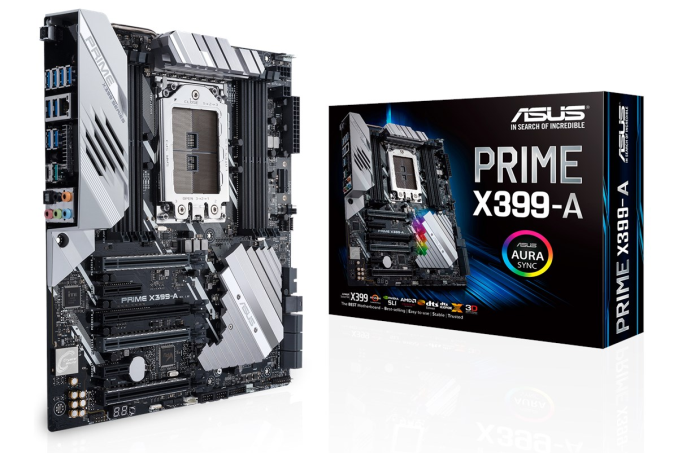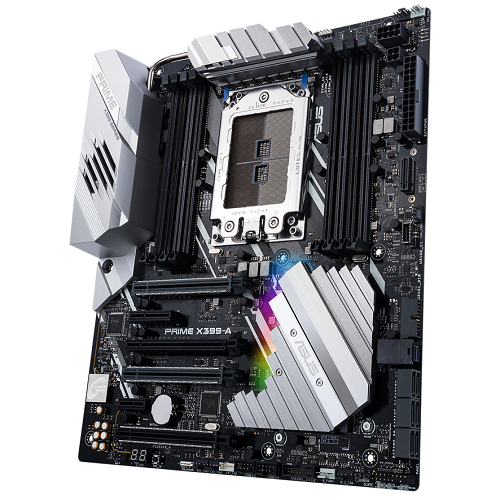An AMD Threadripper X399 Motherboard Overview: A Quick Look at Seven Products
by Ian Cutress & Joe Shields on September 15, 2017 9:00 AM ESTASUS Prime X399-A
By contrast to the comparison between the two ASRock motherboards, ASUS has positioned their first two products further apart from each other. The Prime X399-A is aimed more at an entry into X399, although the ‘entry’ moniker might be misleading: these X399 motherboards are still being stacked to the hilt in functionality even for the ‘cheaper’ models.
The ASUS Prime X399-A follows previous Prime-A products in a white/grey styling, using a brushed metal and angled design across the heatsinks and PCB to show that this motherboard means business (or something like that). The key features of the Prime X399-A are going to be the extended power delivery heatsink arrangement, U.2 and M.2 storage support, ASUS’ upgrade to the Realtek audio and RGB support.
The baseline specifications for the majority of Threadripper boards are here: a full complement of 8 DIMMs for memory, a good set of PCIe slots for multiple-add in cards, SATA storage, Ethernet and USB 3.1 (10 Gbps) support. ASUS, by comparison to the ROG Zenith, has stripped this model down: there’s only one Ethernet port, no WiFi, only two M.2 slots, fewer USB ports (but still over a dozen), and fewer PCIe slots with reinforcement. Threadripper is a high-end product, so doing a complete strip down to the bare essentials negates the high-end aspect of the platform. Perhaps a surprise over the ROG is that the Prime-A has a two-digit LED debug, while the ROG does not.
Going through the board in detail, starting at the top, is the VRM arrangement. This is an eight-phase design, with a dual connected heatsink reaching around the memory slots to the rear panel, which has a small 40mm fan. On the other side of the socket, ASUS has placed both EPS connectors (one 8-pin, one 4-pin) on the top right of the board with the 24-pin ATX connector directly below. While this area is where ASUS normally places some of its more esoteric features, such as PCIe slot disabling switches, there is no need to here. Perhaps a little strange to most will be the placement of the M.2 slot underneath the 24-pin, which requires the M.2 be placed ‘standing-up’ and out of the board. ASUS provides an M.2 bracket to assist in rigidity here.
Below the M.2 is the onboard USB 3.1 (10 Gbps) header from the chipset, which is slowly becoming adopted as the onboard standard, with a small number of chassis manufacturers adopting it for adding front-panel ports. This is followed by one of the two USB 3.0 headers, a U.2 port, and six SATA ports.
The chipset heatsink, as shown by the RGB on the picture, houses a few LEDs to adjust the aesthetic through the onboard AURA SYNC software. The heatsink also houses an M.2 slot, like the ROG, and helps provide additional cooling for it if needed.
To the left of the chipset are the PCIe slots. In order to save some cost and provide a little bit of product differentiation, ASUS has decided to only equip three of the full-length slots with a reinforcement guard, although all four full-length slots are connected to the CPU. The full length slots are provided as x16/x8/x16/x8, and when users equip multiple graphics cards, the slots with the reinforcement guard are the best ones to use. The one without the guard is not worse in any way, however in a two or three card system, using x16/x16 or x16/x16/x8 is usually preferred to x16/x8 or x16/x8/x8 due to the slot spacing arrangement. There is an additional PCIe 2.0 x4 from the chipset present as well.
Below the PCIe slots are the onboard headers, including USB 3.0 headers, fan headers, RGB LED headers and a two-digit debug. This is also paired with a power button to test the motherboard when a hand is in the case but the case is not hooked up. To the right of this is the onboard audio, to which ASUS uses their customized version of the Realtek ALC1220. This is combined with upgraded filter caps, PCB separation, an EMI shield and a DTS software stack.
The rear panel, due to the positioning of the board, might look a little bare compared to the ROG. There is the BIOS reset button, a total of eight USB 3.0 ports, the gigabit Ethernet port provided via the Intel I211-AT controller, a USB 3.1 Type-A port and Type-C port from an ASMedia controller, and the audio jacks with SPDIF output.
| ASUS Prime X399-A | |
| Warranty Period | 3 Years |
| Product Page | Link |
| Price | $349.99 |
| Size | E-ATX |
| CPU Interface | TR4 |
| Chipset | AMD X399 |
| Memory Slots (DDR4) | Eight DDR4 Supporting 128GB Quad Channel Up to 3600 MHz (OC) |
| Network Connectivity | 1 x Intel I211-AT GbE |
| Wireless Network | N/A |
| Onboard Audio | SupremeFX S1220A |
| PCIe Slots for Graphics (from CPU) | 4 x PCIe 3.0 x16 Supports SLI/CF |
| PCIe Slots for Other (from Chipset) | 1 x PCIe 2.0 x4 (max) 1 x PCIe 2.0 x1 |
| Onboard SATA | 6x Supporting RAID 0/1/10 |
| Onboard SATA Express | None |
| Onboard M.2 | 2 x PCIe 3.0 x4 - NVMe or SATA |
| Onboard U.2 | 1 x |
| USB 3.1 | 1 x Type-A Port 1 x Type-C Port |
| USB 3.0 | 8 x Rear Panel Ports 2 x Headers |
| USB 2.0 | 2 x Headers |
| Power Connectors | 1 x 24-pin EATX 1 x 8-pin ATX 12V 1 x 4-pin ATX 12V |
| Fan Headers | 1 x M.2 1 x CPU 1 x CPU OPT 3 x Chassis 1 x AIO_PUMP 1 x 5-pin EXT_FAN |
| IO Panel | 1 x Intel NIC 1 x USB 3.1 Type-A 1 x USB 3.1 Type-C 8 x USB 3.0 Ports 1 x Optical S/PDIF out 5 x Audio jack 1 x USB BIOS Flashback Button |













99 Comments
View All Comments
nathanddrews - Friday, September 15, 2017 - link
The ROG Zenith has all the networking IO I want, but is lacking in SATA ports. Hmm...tarqsharq - Friday, September 15, 2017 - link
With all those extra PCI-E lanes you can just use add-in boards for anything you need more of.Gothmoth - Friday, September 15, 2017 - link
yeah lol at another 100 euro... i tried SATA cards from 6 different brands and all SUCKED.delock, i-tec, syba, logiclink.
just read the reviews at retailers.. these cheap cards are buggy as hell.
i ended up with an adaptec card that works well. but it cost 100+ euro.
nathanddrews - Friday, September 15, 2017 - link
Yes, that has been my experience as well.ddriver - Friday, September 15, 2017 - link
Cheap SATA controller cards use exactly the same chips which mobo makers put to increase the number of ports up from what the chipset provides. Complaining the board doesn't come with extra ports via a cheap controller and then complaining cheap controllers are no good? Seriously?A proper TR build would be at least 3000$, in that price range, 200$ for a good HBA like the LSI 9300-8i should not be an issue. Surely, AMD offers great value and brought extremely high performance to a new level of affordability, but this is not, I repeat, NOT a product for penny pinchers.
mWMA - Monday, September 18, 2017 - link
The correct solution adding more sata is not use SAS2 cards. You can pick up a nice x4 PCIe G3 lsi or IBM SAS2 card for about 100 bucks or less on ebay.. Without any HBA, you can run 8 drives off those 2 sas controller cards since each one will give you x4 lanes.. you can get easily 500+ MB/s out of each controller.mWMA - Monday, September 18, 2017 - link
Correction.. not to use SATA cards.. use SAS2 or SAS3 cards insteadBoemlauweBas - Friday, October 20, 2017 - link
The problem however, these cards suck a golfball through a garden hose performance wise compared to onboard softraid. And before people go ape-sh!t that softraid is bad-mkay... ever looked under the hood of lets say .... EMC / NetApp or any NAS semi/pro vendor out there ? It's all Softraid. Why ? Because the hardware raid chipsets that can actually cope with 3Gb/8Gb throughput are relative new & start around 3K $. So, a poor mans 8x sata 600 onboard chipset is hard 2 beat.karatekid430 - Thursday, October 26, 2017 - link
Yeah, you can get U.2 SFF-8643 to 4x SATA branch-out cables. I have a feeling it won't work directly off U.2 PCIe 3.0 x4 (although who knows?), but surely a PCIe SAS controller providing some SFF-8643 connectors will work. That is the way I was thinking.CheapSushi - Sunday, September 17, 2017 - link
How about going for something more serious then instead of low end: http://www.highpoint-tech.com/USA_new/series-ssd71...That would give you 16 SATA drives.